The umbrella plant is also known as the Schefflera actinophylla, parasol plant, the octopus tree, and the dwarf umbrella tree. This native of Taiwan has become a gorgeous plant to use when you want to add some very handsome foliage to your gardening or landscaping.
Types of Umbrella Plants
Schefflera Arboricola
When looking to recognize the Arboricola Trinette and see what it can add to your home, you’ll find that it comes in a green variety and variegated variety.
The former is a lovely uniform, dark and shiny green, while the latter has creamy white or light yellow streaks. The leaves themselves are long and rather oval-shaped, and the tops of the plant spread out in a circle of five to nine leaves, which give the plant its unique umbrella-like appearance. During the summer, you may see red spiky flowers that will eventually turn into orange berries.
Dwarf Umbrella Tree
Also known as the Miniature umbrella tree (Schefflera arboricola), it is a common dwarf octopus tree. The leaves may be all green, yellow-green, or white-green variegated cultivars. Young plants have fewer leaves in the compound leaves, and adult plants have 7 to 11 leaves.
The leaves are slightly thicker than the octopus tree. They are usually about 6 feet high, but their height can reach 10 to 13 feet, and small yellow-green flower strings are about 30 cm long. They can become a potted plant or bonsai. Air roots will grow when the growth conditions are good, which is quite beautiful.
Podophyllum Peltatum (American Mayapple)
Podophyllum is about 30 to 40 cm (12 to 16 inches) high, and the stem splits into two “Y” shaped branches at about two-thirds height. The leaf is large, dark green, and palate. It can split into 5 to 9 small leaves.
Each leaf is about 20 to 30 cm (8 to 12 inches) in diameter and looks like an umbrella. A white flower, 3 to 5 cm (1.2 to 2 inches) in diameter, offset to one side, blooms at the split of the stem.
Some slightly oval fruits 2-5cm (0.8-2 inches) long will grow and ripen in summer (June to August). They are yellow-green and lemon-scented when ripe, and are eaten or made into jam.
Although it is called “Mayapple”, it only blooms in May, and its fruit does not ripen until summer. Podophyllum peltatum can be propagated by seed sowing in autumn. It prefers fertile, well-drained areas in partial or full shade.
Podophyllum plants are sturdy and immune to pests and diseases. It can grow in one place for many years.
The propagation of podophyllum leaves is very simple. At the end of summer, the rhizomes with regenerated shoots are separated from the bushes and planted to a depth of 5-7 cm at a distance of 20-25 cm from each other.
Schefflera Farinose
It is a yellow-green variegated cultivar native to Malaysia and Indonesia. The plant is taller than the Schefflera arboricola.
Schefflera digitata
It is native to New Zealand. The branches and leaves are relatively sparse. The front end of the green leaves is pointed and long, with 3 to 9 small leaves. The juice of the tree can treat ringworm sores. The Maori people in New Zealand use their augers to make fires.
Darmera Peltata (Indian Rhubarb)
Darmera peltata in partial shade is a Northwest native plant. It grows into the water along moist stream beds. The plant generally grows quite short, normally at about 2-3 feet tall. It can grow very well in a much moisture soil.
Darmera peltata can be said to be an inverted umbrella plant. The stalk is like a shield with big circular leaves that hold the water well. It is a fantastic plant for the semi-shaded moist area,s especially in gardens that won’t be accommodated many huge leaf plants.
Peacock wood (False Aralia)
The scientific name for this umbrella tree is Plerandra elegantissima, while the old scientific name is Schefflera elegantissima). It is categorized as Araliaceae.
The plant is native to New Caledonia in the Southwest Pacific. It can grow up to 3-5 feet high indoors, with 7-9 leaflets. The leaves are rather narrow, serrated, and dark green.
This species is more difficult to care for. It can get damaged by low humidity or moved from the greenhouse to the house (for example, bought from a gardening store), and leaves fall. The leaves of its cultivar are pink and gradually become creamy yellow.
Diphylleia Cymosa (Umbrellaleaf)
Diphylleia cymosa is having an average height of 40-80 cm. The leaves are shield-shaped, reniform or kidney-shaped round to horizontally oblong. The petiole is 7-20 cm long while the upper petiole is 6-13 cm long.
The lower leaf blade is 19-40 cm long and 20-46 cm wide, The upper leaves are 6.5-31 cm long and 19-42 cm wide.
It has 2-lobed, with irregular serrations on the margins. It has a sparsely pubescent or nearly glabrous surface, and is pubescent on the back.
Cyperus Alterniflius (Umbrella Papyrus)
Cyperus alterniflius belongs to the “Sedge family”, and is one of the most important families of monocotyledonous plants like the “Poaceae” to which rice belongs. Since the Cyperaceae plants have Many growth habits that are similar to rice, it has always been the most troublesome weed in the eyes of rice farmers.
However, because of the large size of the plant, it is easy to be found and removed in the paddy field, so it has never become a paddy field weed. Its traces are found in edges, pools, and ditches.
Cyperus alterniflius was originated in Africa. It has a cylindrical rod as high as 60-100cm, and the top grows a spiral-shaped bract, which looks like an umbrella without an umbrella cloth, so some people directly call it a “broken umbrella”. It has the characteristics of shade resistance, weather resistance, and water immersion resistance, and is very suitable for year-round greening at home.
Umbrella Plant Propagation
It is rather easy if you want to grow a new umbrella plant through propagation. What you can do is cut a portion of the branch from your existing plant. Then take the cutting to propagate a new plant.
Get a glass or jar and put the branch you cut out into the glass filled with water. Then leave it for 3 to 4 weeks.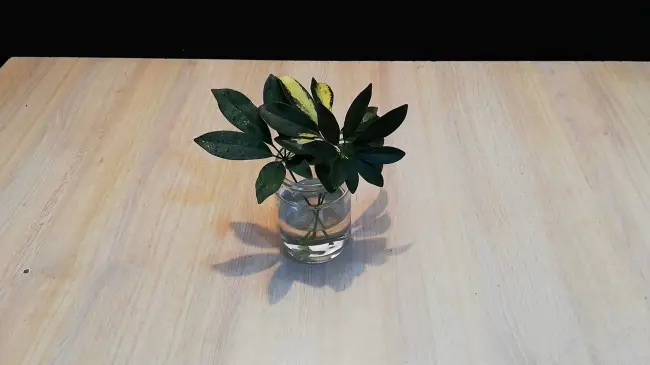
You will find the plant starts rooting. 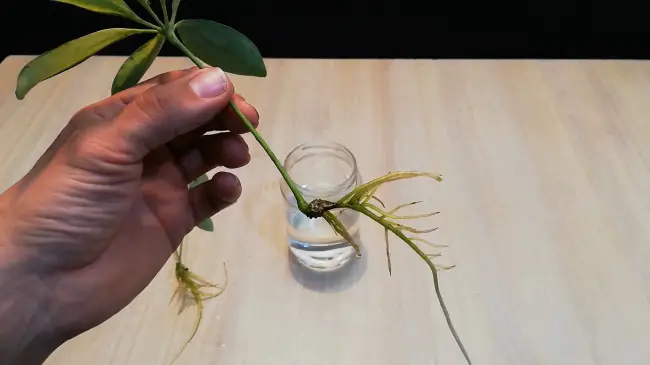
You can get a container to replant it. I use a clay pot and mix it with sand soil(30%), humus(30%), and coco peat(40%). I will plant the umbrella plant in the pot and water it from time to time. 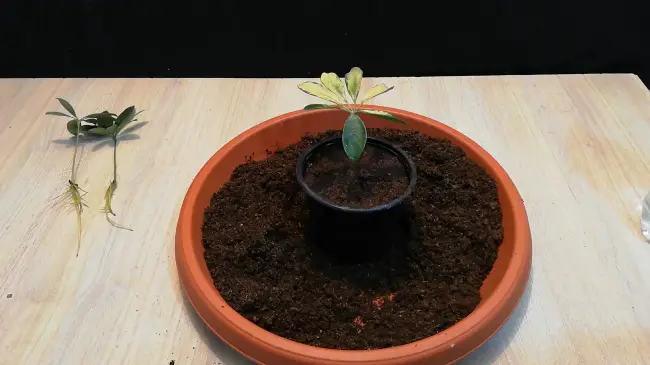
For the plant to get some sunlight, you can place it on a window ledge. By doing so, it can get bright indirect sunlight. Once it is well-planted, it will grow very fast.
When I moved the branch from the old plant where it used to be, I just cut that away. It has rebounded wonderfully, and in fact, it was growing so well that I cut a piece off, and I have done this with it. I actually think I’ve blogged about this area, but you take a clipping and put it in soil water, and there it is. It has succeeded.
I have propagated my Schefflera, and the buds have grown in there. At first, I didn’t know if this would work, but there were leaves on this one. When I planted it, then I trimmed them off. I just let nature take its course, and I have successfully propagated the plant.
I am thrilled to bits about that, and maybe my plant is greener than I thought.
How To Take Care of Umbrella Plant?
What do you need to make sure that your Arboricola Trinette is going to thrive? Please keep it away from hot direct sunlight, but you’ll find that this is a highly adaptable plant. As long as there is a good light source, it can learn to tolerate many situations.
If you notice your plant developing yellowing leaves, you need to give it lighter. Keep in mind that the variegated varieties need more light than other varieties. Also, make sure that you take care to fertilize the plant properly. A small amount of liquid fertilizer is appropriate, but try to keep it very light or stop during the winter months. A period of “hibernation” can be perfect for your plant.
The Umbrella Plant is a good choice if you live in a dryer area or are not all that diligent about watering your plants in general.
Ensure that the soil does not get too wet, and if you keep the plant indoors, make sure that the pot has good drainage. It would help if you only watered it when the soil is nearly dry or the leaves are starting to wilt.
Leaves that fall off or turn black mean that the plant is getting too much water. When growing your Arboricola Trinette indoors, make sure to mix coarse sand or perlite with the soil to keep air flowing through it.
If you are growing your plants outdoors, there are a few pests and diseases that the Arboricola Trinette is particularly vulnerable to.
Be are of mealybug, caterpillars, fungus gnats, and spider mites, which love to nestle under the leaves. Also, keep an eye out for scales and aphids, which can also trouble this short plant.
Take some time and really consider how lovely an umbrella plant can look in your home and garden. They look quite handsome next to showier specimens, and the red flowers that you will get in season can compliment any garden.
The Schefflera does like a lot of light. So the more light you give it, the better it grows.
More on dropping leaves and yellow leaves
One of the things this plant does is you want to keep it evenly moist. Remember, this is a tropical plant, and as such, it doesn’t dry out as it’s not used to real dry soil.
If the plant does begin to dry out, you will notice some of the leaves starting to yellow and fall off. That’s okay because once you start watering it again, it tends to resume growth.
Schefflera can get insects like any other houseplants. One of the things that they could get is fizz and what happens when they get a fizz is the aphids begin to suck out the nice sweet nectar of the plant, and they leave what’s called a little bit of a residue or honeydew on the leaf.
The other pest called sooty mold can come along and starts colonizing on top of the leaves. So if you look at your Schefflera and found black stuff all over it, it probably has sooty mold.
If that happens, you can treat your plant with a block of insecticidal soap and try to wash the leaves as best as possible. I put my umbrella plant outdoors during the course of summer. This can help to keep the insect population low and also tends to wash off the city mold.
What happens when you move a plant from indoor to outdoor during the course of the season?
Inside your home, even if it’s in a bright window, it’s not getting the same strength of light that it would when you move it outside. It would be best to be very careful with this plant when you move it outside, especially during the latter half of the spring and early summer.
If you put it directly in the sun, you’re going to burn the leaves. The leaves will turn almost white and then fall off. Eventually, they will get new leaves, and the new leaves will be used to the sun.
But if you want to avoid that problem from happening, you should start your plant outside in bright light and ever so slowly move it into direct sunshine over the course of a week.
Umbrella Plant Pruning
I have an umbrella plant that is probably about 15 feet or so is growing outdoors. These are very easy to prune. Just be sure to take it all the way back to where it comes out of the main stem.
Otherwise, you’re going to get a lot more branching on it. You can use the same pruning method if you plant it indoors. Indoors it’s going to grow slowly, so it’s not going to need as much pruning as outdoors. It may just get a little bit on the leggy side because it’s not getting the light at once, or the air is dry. You can give it a good hard prune all the way back, and that will rejuvenate it.
If you found a branch that crosses over, you can take it right out and open it up even more shoe. You may take out the branch crossing over a bit, and it may even get some small growth coming up.
If you have it as a house plant and yours has gotten on the leggy side, which it probably has, you can actually take these back all the way down. What’s going to happen is that there will be a node where you can measure the part that you want to cut.
I normally do it as an angle because I usually prune an angle then the new growth will come out there. They are very easy to prune. If you want to keep it lower, you could do a total tip on it. It can take the pruning so well.
You can also use it in bonsai. Any plant that is a bonsai can take pruning because the plant with a trunk in a pot can take a good hard prune.
How Often Should You Water the Plant?
Before watering the umbrella plant, you must first check out the dryness of the soil. Normally, you need to water the plant once a week. You can choose to water the soil thoroughly when watering.
However, during summer, the water will evaporate faster, so you need to water twice a week. During winter, the temperature is low, and the plant will not need so much water. You may water the plant once a month.
You shouldn’t worry. Your plant will get wither if only water it once a month during winter. It won’t
Umbrella plants like acidic water. Some natural waters such as rain and river water are relatively acidic and suitable for watering when watering.
Is the plant poisonous to dogs and cats?
The plant contains insoluble calcium oxalates, terpenoids, and saponins. Although these toxics are not fatal to dogs, cats, and other small animals, they may cause vomiting or diarrhea if they accidentally eat the plant. Therefore, you should be aware of this and keep your pets away from reaching the plant.
How tall can the plant grow?
If you grow the plant outdoors, it can grow up to 8 or 9 meters tall; if you grow indoors, it can grow up to 2 to 3 meters.
How fast can it grow?
Each year, the umbrella plant can grow 3 feet(about 1 meter) in height. So, it may take 8 years to reach 24 feet (8 meters) in height.
Do this plant bloom?
No, the umbrella plants do not bloom. If you want to know their different species, you can identify the unique leaf markings on the different types of Schefflera.
Read also:

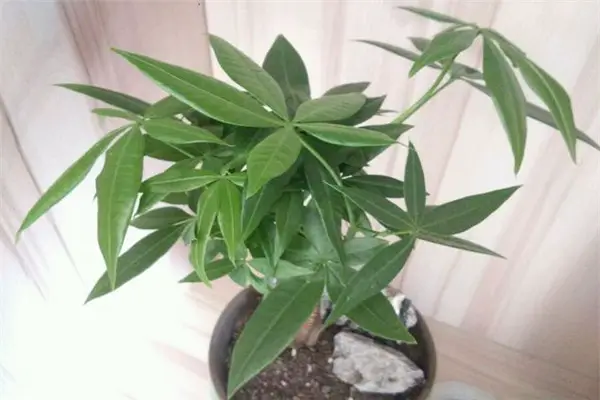
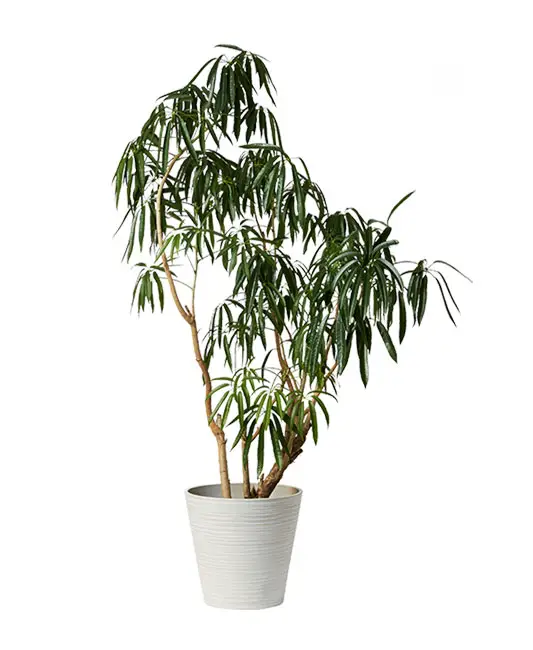
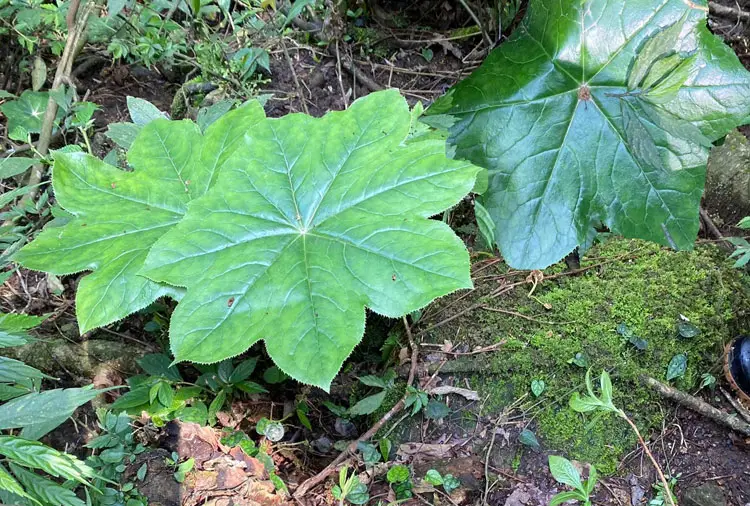
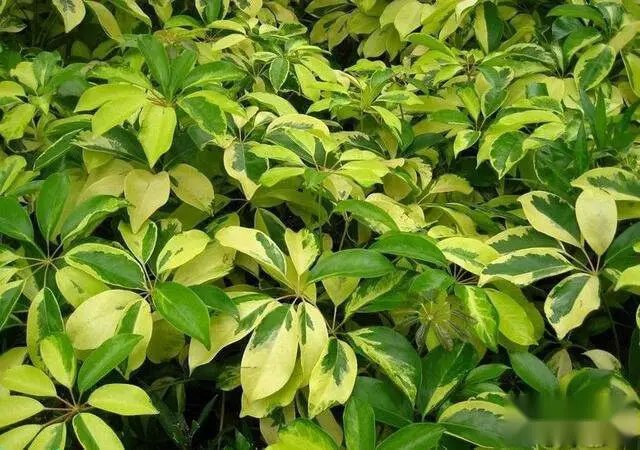
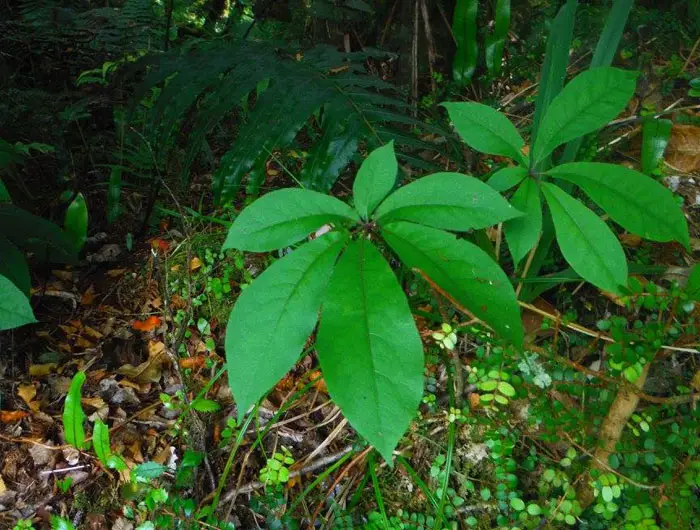
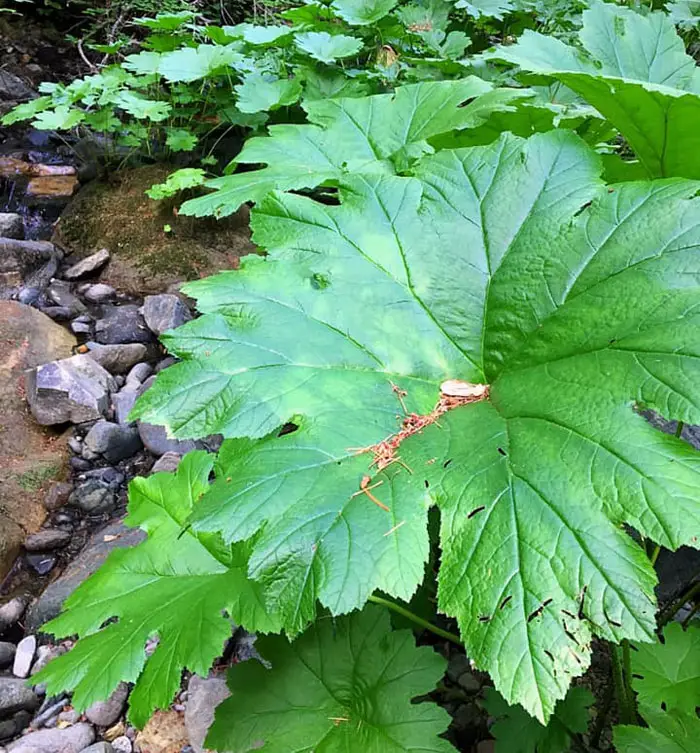
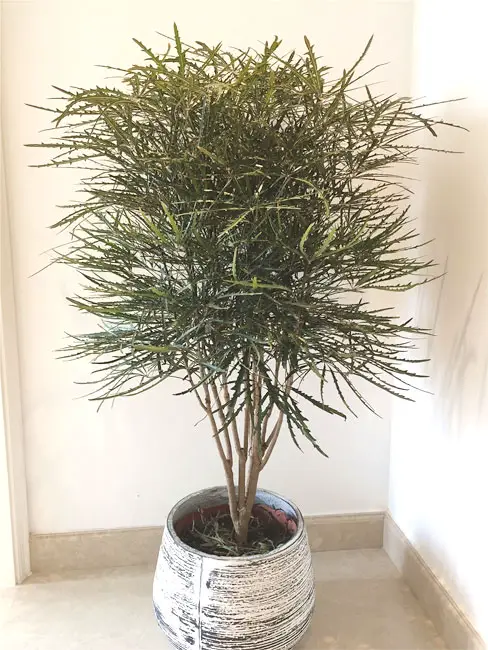
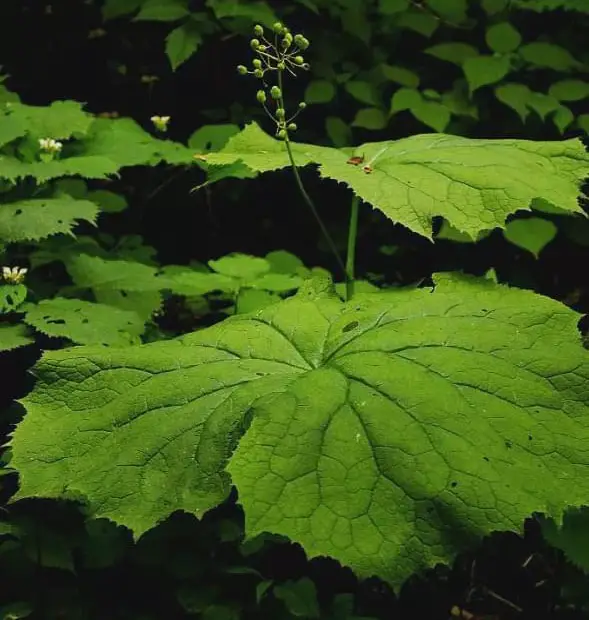
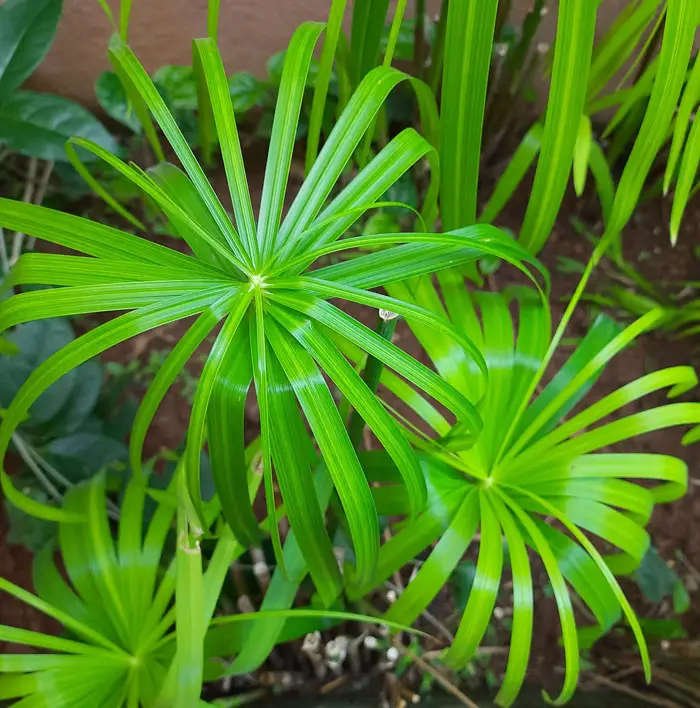
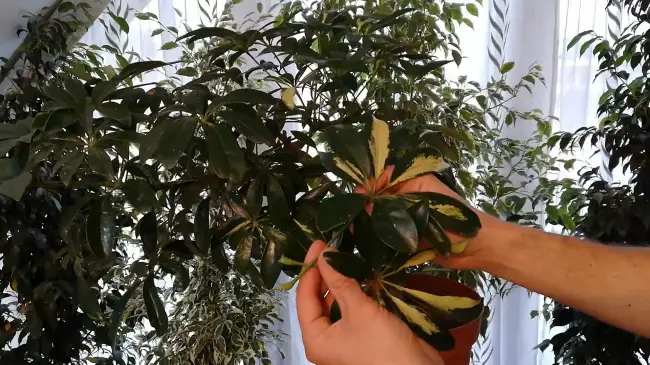
My mother has an indoor umbrella plant that’s older than me. It’s pushing 35+ years. I’m trying to figure out what type exactly it is, can I send a picture to help identify it?
Yup, you can send it to [email protected]